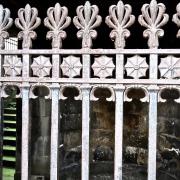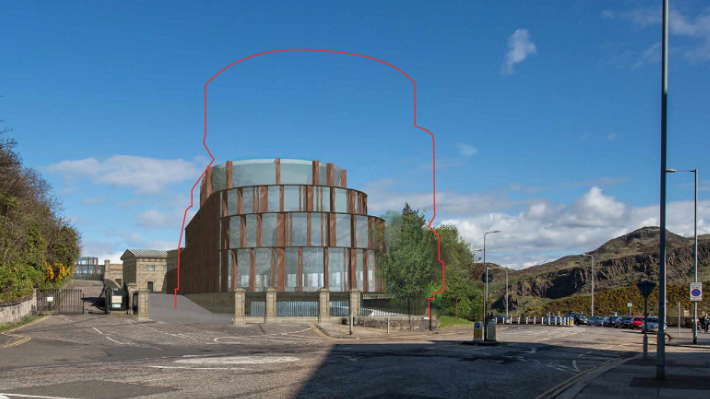
DEVELOPERS SEEK TO PROGRESS WITH SCALED-DOWN PROPOSALS
Revised plans by Duddingston House Properties (DHP) and the Urbanist Group (UG) for a new luxury Rosewood hotel in and around the old Royal High School have been scaled down in the latest set of proposals.
The design is a direct response to rejection of the previous plans.
In acknowledging the sensitivities of the site the project partners have carried out a thorough review of all aspects of the hotel design and are proposing a revised scheme that is substantively reduced to address concerns regarding the landscape and heritage impact of the project.
The new scheme, so far comprising aspirations and artistic impressions rather than architectural detail, went on public display today (until 7pm). These mock-ups appear to show a substantial reduction in the height and depth of (particularly) the western accommodation block, which also seems to be repositioned further back from the road.
Reduction in the size of corridors and back-of-house areas have made the physical transformation possible.
In the pictures below, the former dimensions are outlined in red.


In this way, the view looking eastwards from Waterloo Place would be less obstructed, as would the view of the Calton Hill backdrop. However, a word of caution – these are artistic impressions only.
Throughout the exhibition there are a number of amusing swipes at the St Mary’s Music School designs. For example:
Minmimal interventions to the historic building fabric are proposed. Large, intrusive alterations to the important facades of the building are avoided and care will be taken to ensure the integrity of the architecture is not only maintained but enhanced.
The backers of the previous South American piles of beer mats clearly aim to seize back the heritage-related moral high ground.
Architectural language
The ‘curving, stepped forms’ have now been adjusted so as not to interrupt long views, claim the exhibition boards.
Furthermore, cladding materials are chosen to reflect the geology of Salisbury Crags and Calton Hill:
The design proposes a dark brown pre-patinated copper cladding material with bespoke, facetted surfaces that ensures the new bedroom wings meld successfully with the hillside backdrop from all the key city viewpoints, while at the same time offering a crafted quality and lustre to the facades when viewed at close quarters.
If the artistic impressions are to be believed, these facetted surfaces have an almost Romulan ability to cloak the new elements of the design.

However, the example on show outside the exhibition was not immediately attractive.

You can see more projected images and background information about the new scheme here.
Access and events
Bars, restaurants, gallery and performance spaces would still feature in the central Hamilton building. The developers claim these would be ‘publicly accessible’ to Scottish and Edinburgh residents, although how that could be guaranteed in a privately managed organisation escapes us. Again from the exhibition boards:
The inclusive strategy is designed specifically not to be mono-cultural and not to focus on relatvely few events that are to apppeal to a narrow audience. In keeping with Rosewood's track record the approach will to be [sic] far more democratic appealing across generations and interests with weekly events designed to engage with local and global visitors, creating experiences for all.
As well as an undertaking on future policy, that sounds to our ear like another thinly veiled dig at St Mary's Music School, in particular the potential inclusiveness of its cultural offering here.
Money talks
The total number of bedrooms may be reduced from 147 to as few as 125 (the Council's stipulated minimum), with a final decision on numbers still to be made.
In financial terms, says UG’s Taco van Heusden, the economic model has changed. The weak pound has made hotel rooms in Britain 20 per cent cheaper, and is likely to reduce construction costs. Brexit, he says, has not unsettled international investors in the scheme. ‘Scotland will still exist. Edinburgh will remain a popular tourist destination.’
Despite the smaller scheme proposed, the developers’ confidence in its positive economic impact is undiminished. They say it would still add £36 million to Gross Domestic Product, create around 250 high-quality local jobs and a further 650 in the supply chain. It would, they say, benefit Edinburgh and the Scottish exchequer to the tune of £16 million via business rates and corporate income tax.
What next?
The new scheme has been worked up in consultation with Planning officials to take account of ‘heritage aspects and public comment on previous proposals. However, the earlier scheme, whose rejection by City of Edinburgh Council is now the subject of a sisted appeal, has not been withdrawn. This seems illogical to us, but we’re not experts and our questions on the subject received no answer.
A detailed planning application for the latest set of proposals will be submitted to the Council in early 2017. Only then will we be able to have a good rummage in the details to see what is truly on offer.
DHP’s Bruce Hare said back in December 2015 that the developers had until 2022 to ‘purify the missives’. This has been taken by some to mean they have until 2022 to gain planning permission. However, van Heusden told Spurtle today that 2022 is simply when the developers’ contract with the Council terminates. We asked him whether some earlier deadline for securing planning permission exists, and whether this might explain the developers’ decision to bring forward today’s revised plan with some speed. Van Heusden declined to confirm or deny any such deadline, saying such matters were covered by commercial confidentiality.
Unless or until DHP and UG back away from the project, the proposal for an expanded St Mary’s Music School here (which secured planning consent in August) will not go ahead.
Got a view? Tell us at spurtle@hotmail.co.uk and @theSpurtle and Facebook
-------------
@theSpurtle @oldRoyalHigh Horrible.
 Dominic Berry The new building is still an eyesore, and totally out of keeping with its magnificent site. And a swanky hotel is still the wrong use for this hugely important historic building.
Dominic Berry The new building is still an eyesore, and totally out of keeping with its magnificent site. And a swanky hotel is still the wrong use for this hugely important historic building.
Paul Foley Does every new building have to be in keeping with its neighbours?
Dominic Berry No, but this is a highly sensitive designed landscape containing monumental Greek revival buildings in stone within a World Heritage Site. One should no more think of tacking a glass Inca-style hotel onto the Royal High School than one would do so to, say, Westminster Abbey.
 Kate Kelly Grotesque
Kate Kelly Grotesque
@theSpurtle Why would we want that ugly structure in our city. Think again developers.
 Email from Nicholas Hotham, Head of Outreach & Advocacy, Edinburgh World Heritage: ‘Based on the very limited information available, the revised hotel proposals for the old Royal High School continue to be inappropriate for this world-class building. The bedroom wings are too large for the setting of the Royal High School, one of the three finest Greek Revival buildings in the world, compromising views of the building and the rus in urbe in the city intended in its siting and construction. We’d be surprised if the development team can make the economics of this scheme work, having previously claimed that the economics of the previous proposal were on a knife edge. The most sensible thing to do would be to withdraw and allow the fully approved and funded plans for the music school to go ahead.’
Email from Nicholas Hotham, Head of Outreach & Advocacy, Edinburgh World Heritage: ‘Based on the very limited information available, the revised hotel proposals for the old Royal High School continue to be inappropriate for this world-class building. The bedroom wings are too large for the setting of the Royal High School, one of the three finest Greek Revival buildings in the world, compromising views of the building and the rus in urbe in the city intended in its siting and construction. We’d be surprised if the development team can make the economics of this scheme work, having previously claimed that the economics of the previous proposal were on a knife edge. The most sensible thing to do would be to withdraw and allow the fully approved and funded plans for the music school to go ahead.’
 Royal High School SOS shared Broughton Spurtle's photo.
Royal High School SOS shared Broughton Spurtle's photo.The Spurtle catches the spirit of the sketches on display: 'If the artistic impressions are to be believed, these facetted surfaces have an almost Romulan ability to cloak the new elements of the design.' Just how DO acres of the glass appear to blend with the surrounding hill? There were stuck on bits of foam board, concealing names of absented supporters and none of the bullish optimism and cups of tea of the previous consultation... Perhaps it has been understood that when it comes to occupying a national treasure such as the Royal High School, a fancy hotel doesn't trump a music school!
@theSpurtle Are Incan terraces more or less appropriate than the music school's proposed Japanese pavilions?
@theSpurtle Same dilemma. Hotel worse for wider setting of RHS. Music school worse for fabric of RHS building. Both approaches have a case.


